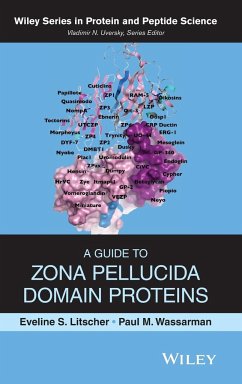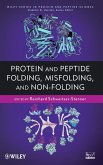- Gebundenes Buch
- Merkliste
- Auf die Merkliste
- Bewerten Bewerten
- Teilen
- Produkt teilen
- Produkterinnerung
- Produkterinnerung
This book provides a coherent, clear, and uniform presentation of structural, genetic, molecular, and biochemical information available for the zona pellucida domain protein family, which impact pathologies such as infertility, deafness, and cancer. Furthermore it: * Details information about the structure and function of the ZP domain in ZPDC-proteins * Provides illustrations of the organization of ZPDC-proteins, the genes that encode the proteins, and examples of mutations in the ZP domain that cause diseases * Speculates as to the evolution of the ZP domain and potential therapeutics for…mehr
Andere Kunden interessierten sich auch für
![Protein and Peptide Folding, Misfolding, and Non-Folding Protein and Peptide Folding, Misfolding, and Non-Folding]() Protein and Peptide Folding, Misfolding, and Non-Folding195,99 €
Protein and Peptide Folding, Misfolding, and Non-Folding195,99 €![Fusion Protein Technologies for Biopharmaceuticals Fusion Protein Technologies for Biopharmaceuticals]() Fusion Protein Technologies for Biopharmaceuticals168,99 €
Fusion Protein Technologies for Biopharmaceuticals168,99 €![Protein Aggregation in Bacteria Protein Aggregation in Bacteria]() Protein Aggregation in Bacteria158,99 €
Protein Aggregation in Bacteria158,99 €![Protein Families Protein Families]() Protein Families171,99 €
Protein Families171,99 €![Protein Oxidation and Aging Protein Oxidation and Aging]() Tilman GruneProtein Oxidation and Aging193,99 €
Tilman GruneProtein Oxidation and Aging193,99 €![Enzyme Engineering Enzyme Engineering]() Manfred T. ReetzEnzyme Engineering159,00 €
Manfred T. ReetzEnzyme Engineering159,00 €![Fluorescent Analogs of Biomolecular Building Blocks Fluorescent Analogs of Biomolecular Building Blocks]() Marcus WilhelmssonFluorescent Analogs of Biomolecular Building Blocks205,99 €
Marcus WilhelmssonFluorescent Analogs of Biomolecular Building Blocks205,99 €-
-
-
This book provides a coherent, clear, and uniform presentation of structural, genetic, molecular, and biochemical information available for the zona pellucida domain protein family, which impact pathologies such as infertility, deafness, and cancer. Furthermore it:
* Details information about the structure and function of the ZP domain in ZPDC-proteins
* Provides illustrations of the organization of ZPDC-proteins, the genes that encode the proteins, and examples of mutations in the ZP domain that cause diseases
* Speculates as to the evolution of the ZP domain and potential therapeutics for diseases stemming from ZP domain mutations
* Addresses mammalian and non-mammalian systems
Hinweis: Dieser Artikel kann nur an eine deutsche Lieferadresse ausgeliefert werden.
* Details information about the structure and function of the ZP domain in ZPDC-proteins
* Provides illustrations of the organization of ZPDC-proteins, the genes that encode the proteins, and examples of mutations in the ZP domain that cause diseases
* Speculates as to the evolution of the ZP domain and potential therapeutics for diseases stemming from ZP domain mutations
* Addresses mammalian and non-mammalian systems
Hinweis: Dieser Artikel kann nur an eine deutsche Lieferadresse ausgeliefert werden.
Produktdetails
- Produktdetails
- Wiley Series in Protein and Peptide Science
- Verlag: Wiley & Sons
- 1. Auflage
- Seitenzahl: 208
- Erscheinungstermin: 7. Juli 2015
- Englisch
- Abmessung: 240mm x 161mm x 15mm
- Gewicht: 472g
- ISBN-13: 9780470528112
- ISBN-10: 0470528117
- Artikelnr.: 38145761
- Herstellerkennzeichnung
- Libri GmbH
- Europaallee 1
- 36244 Bad Hersfeld
- gpsr@libri.de
- Wiley Series in Protein and Peptide Science
- Verlag: Wiley & Sons
- 1. Auflage
- Seitenzahl: 208
- Erscheinungstermin: 7. Juli 2015
- Englisch
- Abmessung: 240mm x 161mm x 15mm
- Gewicht: 472g
- ISBN-13: 9780470528112
- ISBN-10: 0470528117
- Artikelnr.: 38145761
- Herstellerkennzeichnung
- Libri GmbH
- Europaallee 1
- 36244 Bad Hersfeld
- gpsr@libri.de
Eveline S. Litscher, Ph.D., is Assistant Professor in the Department of Developmental and Regenerative Biology at the Icahn School of Medicine at Mount Sinai in New York City. Previously a Swiss National Science Foundation post-doctoral fellow in the Department of Cell and Developmental Biology at the Roche Institute of Molecular Biology, she has more than 20 years of research experience working on extracellular coat proteins of mammalian and non-mammalian eggs, and has published more than 45 primary papers and reviews. Paul M. Wassarman, Ph.D., is Professor in the Department of Developmental and Regenerative Biology at the Icahn School of Medicine at Mount Sinai in New York City. Previously a faculty member in the Department of Biological Chemistry at Harvard Medical School and in the Department of Cell and Developmental Biology at the Roche Institute of Molecular Biology, he has more than 35 years of research experience working on extracellular coat proteins of mammalian and non-mammalian eggs, and has published more than 220 primary papers and reviews.
List of Tables xi
Introduction to the Wiley Series on Protein and Peptide Science xiii
Preface xv
Acknowledgments xvii
List of Abbreviations xix
Part A Zona Pellucida Domain Proteins 1
A.1 Nature of the Zona Pellucida Domain 1
A.2 Mouse ZP Proteins 2
A.3 Synthesis, Secretion, and Assembly of ZP Proteins 7
A.4 Structure of the ZPD 13
A.5 Evolution of ZPD Proteins 18
Part B Mammalian Zona Pellucida Proteins 21
B.1 Introduction 21
B.2 Monotremes 22
B.3 Marsupials 24
B.4 Placental Mammals 25
B.4.a Mouse 26
B.4.b Rat 26
B.4.c Hamster 28
B.4.d Rabbit 30
B.4.e Cow 32
B.4.f Pig 33
B.4.g Dog 35
B.4.h Monkey 36
B.4.i Chimpanzee 38
B.4.j Human 40
B.5 Mammalian ZP Proteins as Antifertility Vaccines 45
B.6 Summary Tables 48
Part C Mammalian Zona Pellucida Domain Proteins 53
C.1 Betaglycan/TGFß?]Receptor Type III 53
C.2 CUB and Zona Pellucida?]like Domain 1 (CUZD?]1) Proteins 55
C.2.a UTCZP/Itmap-1 55
C.2.b UO-44/ERG-1 56
C.3 Deleted in Malignant Brain Tumor 1 (DMBT1) Proteins 58
C.3.a CRP-Ductin 58
C.3.b DMBT1 60
C.3.c Ebnerin 62
C.3.d Hensin 63
C.3.e Vomeroglandin 65
C.4 Endoglin/CD?]105 66
C.5 Liver?]Specific ZPD?]Containing Protein (LZP) 68
C.6 Oocyte?]Secreted Protein 1 (Oosp1) 69
C.7 Pancreatic Zymogen Granule Protein (GP?]2) 70
C.8 Placenta?]Specific 1 (Plac1) 71
C.9 Tectorin?]¿ and ?]ß 72
C.10 Uromodulin/Tamm-Horsfall Protein 78
C.11 Uromodulin?]like Proteins 81
C.12 Summary Tables 84
Part D Non?]mammalian Zona Pellucida Domain Proteins 87
D.1 Jellyfish (Aurelia aurita) 87
D.1.a Mesoglein 87
D.2 Sea Urchins (Strongylocentrotus purpuratus) 90
D.2.a Oit-3 90
D.2.b UO-44 90
D.3 Nematodes (Caenorhabditis elegans) 91
D.3.a Cuticlins 91
D.3.b DYF-7 93
D.3.c RAM-5 94
D.4 Mollusks (Haliotis rufescens) 96
D.4.a Vitelline envelope ZPs 96
D.5 Fruit Flies (Drosophila melanogaster) 101
D.5.a Dusky (dy), dusky-like (dyl), and miniature (m) 102
D.5.b Dumpy (dp) 104
D.5.c NompA (nompA) 105
D.5.d Papillote (pot) and piopio (pio) 107
D.5.e Quasimodo (qsm) 109
D.5.f Shavenbaby target genes (cyr, dyl, m, mey, neo, nyo, tyn, and zye)
109
D.6 Tunicates: Vitelline Coat Proteins and Oikosins 113
D.6.a Ciona: CiVC-16, -20, -182-1, -569 114
D.6.b Halocynthia: HrVC-120, HaVC-130 115
D.6.c Oikopleura: oikosins 117
D.7 Fish: Vitelline Envelope Proteins 118
D.7.a Salmonidae 119
D.7.b Cyprinidae 121
D.7.c Sparidae 122
D.7.d Adrianichthyidae 124
D.7.e Cynoglossidae 125
D.8 Amphibians: Vitelline Envelope Proteins 127
D.8.a Xenopus laevis 127
D.8.b Bufo arenarum 130
D.9 Reptiles: Predicted ZPD Proteins 133
D.9.a Anolis carolinensis 133
D.9.b Chelonia mydas 135
D.9.c Ophiophagus hannah 136
D.10 Birds: Vitelline Envelope Proteins 138
D.10.a Chicken vitelline envelope proteins 140
D.10.b Quail vitelline envelope proteins 143
D.11 Summary Tables 145
Part E Appendix 149
E.1 Sources of Sequence Information 149
E.2 Site(s) of ZP Protein Synthesis 154
E.3 Characteristics of Mammalian and Non-Mammalian ZPD Proteins 155
E.4 Comparison of Vertebrate ZP Proteins and Human ZP1-4 159
E.5 Sequence Alignments of ZPDs with 11 Cys Residues 161
E.5A Positions of Cys Residues of ZPDs with 11 Cys Residues 162
E.5B Positions of Cys Residues of Drosophila ZPDs with 11 Cys Residues 165
Index 167
Introduction to the Wiley Series on Protein and Peptide Science xiii
Preface xv
Acknowledgments xvii
List of Abbreviations xix
Part A Zona Pellucida Domain Proteins 1
A.1 Nature of the Zona Pellucida Domain 1
A.2 Mouse ZP Proteins 2
A.3 Synthesis, Secretion, and Assembly of ZP Proteins 7
A.4 Structure of the ZPD 13
A.5 Evolution of ZPD Proteins 18
Part B Mammalian Zona Pellucida Proteins 21
B.1 Introduction 21
B.2 Monotremes 22
B.3 Marsupials 24
B.4 Placental Mammals 25
B.4.a Mouse 26
B.4.b Rat 26
B.4.c Hamster 28
B.4.d Rabbit 30
B.4.e Cow 32
B.4.f Pig 33
B.4.g Dog 35
B.4.h Monkey 36
B.4.i Chimpanzee 38
B.4.j Human 40
B.5 Mammalian ZP Proteins as Antifertility Vaccines 45
B.6 Summary Tables 48
Part C Mammalian Zona Pellucida Domain Proteins 53
C.1 Betaglycan/TGFß?]Receptor Type III 53
C.2 CUB and Zona Pellucida?]like Domain 1 (CUZD?]1) Proteins 55
C.2.a UTCZP/Itmap-1 55
C.2.b UO-44/ERG-1 56
C.3 Deleted in Malignant Brain Tumor 1 (DMBT1) Proteins 58
C.3.a CRP-Ductin 58
C.3.b DMBT1 60
C.3.c Ebnerin 62
C.3.d Hensin 63
C.3.e Vomeroglandin 65
C.4 Endoglin/CD?]105 66
C.5 Liver?]Specific ZPD?]Containing Protein (LZP) 68
C.6 Oocyte?]Secreted Protein 1 (Oosp1) 69
C.7 Pancreatic Zymogen Granule Protein (GP?]2) 70
C.8 Placenta?]Specific 1 (Plac1) 71
C.9 Tectorin?]¿ and ?]ß 72
C.10 Uromodulin/Tamm-Horsfall Protein 78
C.11 Uromodulin?]like Proteins 81
C.12 Summary Tables 84
Part D Non?]mammalian Zona Pellucida Domain Proteins 87
D.1 Jellyfish (Aurelia aurita) 87
D.1.a Mesoglein 87
D.2 Sea Urchins (Strongylocentrotus purpuratus) 90
D.2.a Oit-3 90
D.2.b UO-44 90
D.3 Nematodes (Caenorhabditis elegans) 91
D.3.a Cuticlins 91
D.3.b DYF-7 93
D.3.c RAM-5 94
D.4 Mollusks (Haliotis rufescens) 96
D.4.a Vitelline envelope ZPs 96
D.5 Fruit Flies (Drosophila melanogaster) 101
D.5.a Dusky (dy), dusky-like (dyl), and miniature (m) 102
D.5.b Dumpy (dp) 104
D.5.c NompA (nompA) 105
D.5.d Papillote (pot) and piopio (pio) 107
D.5.e Quasimodo (qsm) 109
D.5.f Shavenbaby target genes (cyr, dyl, m, mey, neo, nyo, tyn, and zye)
109
D.6 Tunicates: Vitelline Coat Proteins and Oikosins 113
D.6.a Ciona: CiVC-16, -20, -182-1, -569 114
D.6.b Halocynthia: HrVC-120, HaVC-130 115
D.6.c Oikopleura: oikosins 117
D.7 Fish: Vitelline Envelope Proteins 118
D.7.a Salmonidae 119
D.7.b Cyprinidae 121
D.7.c Sparidae 122
D.7.d Adrianichthyidae 124
D.7.e Cynoglossidae 125
D.8 Amphibians: Vitelline Envelope Proteins 127
D.8.a Xenopus laevis 127
D.8.b Bufo arenarum 130
D.9 Reptiles: Predicted ZPD Proteins 133
D.9.a Anolis carolinensis 133
D.9.b Chelonia mydas 135
D.9.c Ophiophagus hannah 136
D.10 Birds: Vitelline Envelope Proteins 138
D.10.a Chicken vitelline envelope proteins 140
D.10.b Quail vitelline envelope proteins 143
D.11 Summary Tables 145
Part E Appendix 149
E.1 Sources of Sequence Information 149
E.2 Site(s) of ZP Protein Synthesis 154
E.3 Characteristics of Mammalian and Non-Mammalian ZPD Proteins 155
E.4 Comparison of Vertebrate ZP Proteins and Human ZP1-4 159
E.5 Sequence Alignments of ZPDs with 11 Cys Residues 161
E.5A Positions of Cys Residues of ZPDs with 11 Cys Residues 162
E.5B Positions of Cys Residues of Drosophila ZPDs with 11 Cys Residues 165
Index 167
List of Tables xi
Introduction to the Wiley Series on Protein and Peptide Science xiii
Preface xv
Acknowledgments xvii
List of Abbreviations xix
Part A Zona Pellucida Domain Proteins 1
A.1 Nature of the Zona Pellucida Domain 1
A.2 Mouse ZP Proteins 2
A.3 Synthesis, Secretion, and Assembly of ZP Proteins 7
A.4 Structure of the ZPD 13
A.5 Evolution of ZPD Proteins 18
Part B Mammalian Zona Pellucida Proteins 21
B.1 Introduction 21
B.2 Monotremes 22
B.3 Marsupials 24
B.4 Placental Mammals 25
B.4.a Mouse 26
B.4.b Rat 26
B.4.c Hamster 28
B.4.d Rabbit 30
B.4.e Cow 32
B.4.f Pig 33
B.4.g Dog 35
B.4.h Monkey 36
B.4.i Chimpanzee 38
B.4.j Human 40
B.5 Mammalian ZP Proteins as Antifertility Vaccines 45
B.6 Summary Tables 48
Part C Mammalian Zona Pellucida Domain Proteins 53
C.1 Betaglycan/TGFß?]Receptor Type III 53
C.2 CUB and Zona Pellucida?]like Domain 1 (CUZD?]1) Proteins 55
C.2.a UTCZP/Itmap-1 55
C.2.b UO-44/ERG-1 56
C.3 Deleted in Malignant Brain Tumor 1 (DMBT1) Proteins 58
C.3.a CRP-Ductin 58
C.3.b DMBT1 60
C.3.c Ebnerin 62
C.3.d Hensin 63
C.3.e Vomeroglandin 65
C.4 Endoglin/CD?]105 66
C.5 Liver?]Specific ZPD?]Containing Protein (LZP) 68
C.6 Oocyte?]Secreted Protein 1 (Oosp1) 69
C.7 Pancreatic Zymogen Granule Protein (GP?]2) 70
C.8 Placenta?]Specific 1 (Plac1) 71
C.9 Tectorin?]¿ and ?]ß 72
C.10 Uromodulin/Tamm-Horsfall Protein 78
C.11 Uromodulin?]like Proteins 81
C.12 Summary Tables 84
Part D Non?]mammalian Zona Pellucida Domain Proteins 87
D.1 Jellyfish (Aurelia aurita) 87
D.1.a Mesoglein 87
D.2 Sea Urchins (Strongylocentrotus purpuratus) 90
D.2.a Oit-3 90
D.2.b UO-44 90
D.3 Nematodes (Caenorhabditis elegans) 91
D.3.a Cuticlins 91
D.3.b DYF-7 93
D.3.c RAM-5 94
D.4 Mollusks (Haliotis rufescens) 96
D.4.a Vitelline envelope ZPs 96
D.5 Fruit Flies (Drosophila melanogaster) 101
D.5.a Dusky (dy), dusky-like (dyl), and miniature (m) 102
D.5.b Dumpy (dp) 104
D.5.c NompA (nompA) 105
D.5.d Papillote (pot) and piopio (pio) 107
D.5.e Quasimodo (qsm) 109
D.5.f Shavenbaby target genes (cyr, dyl, m, mey, neo, nyo, tyn, and zye)
109
D.6 Tunicates: Vitelline Coat Proteins and Oikosins 113
D.6.a Ciona: CiVC-16, -20, -182-1, -569 114
D.6.b Halocynthia: HrVC-120, HaVC-130 115
D.6.c Oikopleura: oikosins 117
D.7 Fish: Vitelline Envelope Proteins 118
D.7.a Salmonidae 119
D.7.b Cyprinidae 121
D.7.c Sparidae 122
D.7.d Adrianichthyidae 124
D.7.e Cynoglossidae 125
D.8 Amphibians: Vitelline Envelope Proteins 127
D.8.a Xenopus laevis 127
D.8.b Bufo arenarum 130
D.9 Reptiles: Predicted ZPD Proteins 133
D.9.a Anolis carolinensis 133
D.9.b Chelonia mydas 135
D.9.c Ophiophagus hannah 136
D.10 Birds: Vitelline Envelope Proteins 138
D.10.a Chicken vitelline envelope proteins 140
D.10.b Quail vitelline envelope proteins 143
D.11 Summary Tables 145
Part E Appendix 149
E.1 Sources of Sequence Information 149
E.2 Site(s) of ZP Protein Synthesis 154
E.3 Characteristics of Mammalian and Non-Mammalian ZPD Proteins 155
E.4 Comparison of Vertebrate ZP Proteins and Human ZP1-4 159
E.5 Sequence Alignments of ZPDs with 11 Cys Residues 161
E.5A Positions of Cys Residues of ZPDs with 11 Cys Residues 162
E.5B Positions of Cys Residues of Drosophila ZPDs with 11 Cys Residues 165
Index 167
Introduction to the Wiley Series on Protein and Peptide Science xiii
Preface xv
Acknowledgments xvii
List of Abbreviations xix
Part A Zona Pellucida Domain Proteins 1
A.1 Nature of the Zona Pellucida Domain 1
A.2 Mouse ZP Proteins 2
A.3 Synthesis, Secretion, and Assembly of ZP Proteins 7
A.4 Structure of the ZPD 13
A.5 Evolution of ZPD Proteins 18
Part B Mammalian Zona Pellucida Proteins 21
B.1 Introduction 21
B.2 Monotremes 22
B.3 Marsupials 24
B.4 Placental Mammals 25
B.4.a Mouse 26
B.4.b Rat 26
B.4.c Hamster 28
B.4.d Rabbit 30
B.4.e Cow 32
B.4.f Pig 33
B.4.g Dog 35
B.4.h Monkey 36
B.4.i Chimpanzee 38
B.4.j Human 40
B.5 Mammalian ZP Proteins as Antifertility Vaccines 45
B.6 Summary Tables 48
Part C Mammalian Zona Pellucida Domain Proteins 53
C.1 Betaglycan/TGFß?]Receptor Type III 53
C.2 CUB and Zona Pellucida?]like Domain 1 (CUZD?]1) Proteins 55
C.2.a UTCZP/Itmap-1 55
C.2.b UO-44/ERG-1 56
C.3 Deleted in Malignant Brain Tumor 1 (DMBT1) Proteins 58
C.3.a CRP-Ductin 58
C.3.b DMBT1 60
C.3.c Ebnerin 62
C.3.d Hensin 63
C.3.e Vomeroglandin 65
C.4 Endoglin/CD?]105 66
C.5 Liver?]Specific ZPD?]Containing Protein (LZP) 68
C.6 Oocyte?]Secreted Protein 1 (Oosp1) 69
C.7 Pancreatic Zymogen Granule Protein (GP?]2) 70
C.8 Placenta?]Specific 1 (Plac1) 71
C.9 Tectorin?]¿ and ?]ß 72
C.10 Uromodulin/Tamm-Horsfall Protein 78
C.11 Uromodulin?]like Proteins 81
C.12 Summary Tables 84
Part D Non?]mammalian Zona Pellucida Domain Proteins 87
D.1 Jellyfish (Aurelia aurita) 87
D.1.a Mesoglein 87
D.2 Sea Urchins (Strongylocentrotus purpuratus) 90
D.2.a Oit-3 90
D.2.b UO-44 90
D.3 Nematodes (Caenorhabditis elegans) 91
D.3.a Cuticlins 91
D.3.b DYF-7 93
D.3.c RAM-5 94
D.4 Mollusks (Haliotis rufescens) 96
D.4.a Vitelline envelope ZPs 96
D.5 Fruit Flies (Drosophila melanogaster) 101
D.5.a Dusky (dy), dusky-like (dyl), and miniature (m) 102
D.5.b Dumpy (dp) 104
D.5.c NompA (nompA) 105
D.5.d Papillote (pot) and piopio (pio) 107
D.5.e Quasimodo (qsm) 109
D.5.f Shavenbaby target genes (cyr, dyl, m, mey, neo, nyo, tyn, and zye)
109
D.6 Tunicates: Vitelline Coat Proteins and Oikosins 113
D.6.a Ciona: CiVC-16, -20, -182-1, -569 114
D.6.b Halocynthia: HrVC-120, HaVC-130 115
D.6.c Oikopleura: oikosins 117
D.7 Fish: Vitelline Envelope Proteins 118
D.7.a Salmonidae 119
D.7.b Cyprinidae 121
D.7.c Sparidae 122
D.7.d Adrianichthyidae 124
D.7.e Cynoglossidae 125
D.8 Amphibians: Vitelline Envelope Proteins 127
D.8.a Xenopus laevis 127
D.8.b Bufo arenarum 130
D.9 Reptiles: Predicted ZPD Proteins 133
D.9.a Anolis carolinensis 133
D.9.b Chelonia mydas 135
D.9.c Ophiophagus hannah 136
D.10 Birds: Vitelline Envelope Proteins 138
D.10.a Chicken vitelline envelope proteins 140
D.10.b Quail vitelline envelope proteins 143
D.11 Summary Tables 145
Part E Appendix 149
E.1 Sources of Sequence Information 149
E.2 Site(s) of ZP Protein Synthesis 154
E.3 Characteristics of Mammalian and Non-Mammalian ZPD Proteins 155
E.4 Comparison of Vertebrate ZP Proteins and Human ZP1-4 159
E.5 Sequence Alignments of ZPDs with 11 Cys Residues 161
E.5A Positions of Cys Residues of ZPDs with 11 Cys Residues 162
E.5B Positions of Cys Residues of Drosophila ZPDs with 11 Cys Residues 165
Index 167








